FREE WHITE PAPER
Mastering Digital Adoption
How erpOI’s OI Approach with WalkMe Unlocks True Platform Value.

Foreword → From Transformation Debt to Digital Dividend
In our years of guiding organizations through complex technological shifts, we have observed a recurring paradox: the more an enterprise invests in digital transformation, the greater the risk of accumulating “transformation debt.” This is the growing chasm between the promise of innovation and the tangible value realized. It manifests as frustrated employees, fragmented processes, and a technology stack that, despite its sophistication, becomes a source of paralysis rather than progress.
Today, the advent of Generative AI represents the most significant technological accelerant of our time. It has the power to turn this transformation debt into an insurmountable liability for those who are unprepared, while offering an unprecedented “digital dividend” to those who master its integration.

This document is not another treatise on the importance of technology. It is a blueprint for a new methodology. It outlines our proprietary Operations Integration and Intelligence (OI) Approach—a holistic framework designed to close the gap between technology and the people who use it. We will demonstrate that the key to unlocking the true value of any platform, especially in the age of AI, lies not in the technology itself, but in a relentless focus on human adoption and continuous, data-driven improvement.
This is the Transformation Continuum. It is the pathway from paralysis to HyperProductivity, and we are proud to be your guide on this essential journey.
Executive Summary →
The Tipping Point of Digital Transformation
The modern enterprise is at a critical inflection point. A projected $5.61 trillion will be invested in IT globally in 2025, yet the returns are diminishing at an alarming rate. The average large enterprise now loses $104 million annually to digital inefficiencies, a direct consequence of “Software Paralysis”—a state where a sprawling, underutilized technology stack actively hinders productivity and stifles innovation. Traditional System Integrators (SIs), with their myopic focus on technical “go-live” over human adoption, have proven incapable of solving this crisis.
The dawn of Generative AI has only raised the stakes. It promises to amplify the success of innovators while accelerating the decline of laggards. The difference between these two outcomes will be defined by one thing: the maturity of their digital adoption strategy.
A new paradigm is essential—one that treats transformation not as a finite project, but as a continuous journey. This is the Transformation Continuum, a model pioneered by erpOI. Our proprietary Operations Integration and Intelligence (OI) Approach is the engine that drives this continuum. It is a holistic methodology that fundamentally realigns the fractured relationship between People, Processes, and Technology. It is the blueprint for creating “Elite Digital Adopters”—the top 7% of organizations that achieve a remarkable 85% ROI on their transformation projects, compared to a mere 22% for those who follow outdated methods.
creates a cohesive, high-performance unit where technology serves the user and processes are intuitive.
leverages a data-first strategy to provide clarity, identify friction, and guide continuous improvement.
This whitepaper details the erpOI OI Approach and demonstrates how, when activated by the market-leading Digital Adoption Platform (DAP), WalkMe, it delivers transformative results. Through in-depth use cases, we will prove how erpOI moves beyond simple implementation to unlock the true, sustained value of your technology investments and sets your organization on the path to HyperProductivity.
Chapter 1: The Digital Paradox - A Crisis of Diminishing Returns
1.1 The $5.61 Trillion Question: Why Record IT Spend Yields Stagnant Productivity
Despite a global economic climate marked by uncertainty, enterprise investment in technology has never been higher. According to Gartner, global IT spending is projected to climb from $5.1 trillion in 2024 to $5.61 trillion in 2025. Enterprises are aggressively increasing their digital transformation budgets by an average of 45% year-over-year.
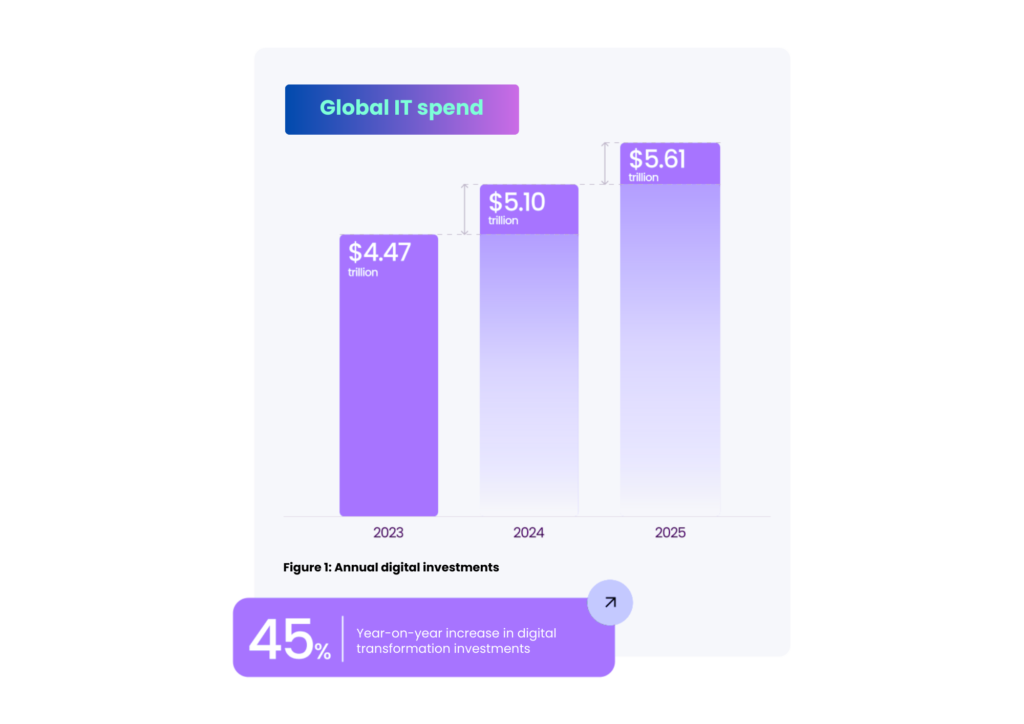
Yet, this record spending is not translating into proportional gains in productivity or value. In 2024, the average large enterprise lost $104 million from digital inefficiencies. This staggering figure can be broken down into three core areas of failure:
Direct costs from employee time spent grappling with technology frustrations and inefficient workflows.
Strategic costs incurred from poor visibility and the underutilization of enterprise applications.
Investment losses from technology initiatives that fail to deliver ROI due to low user adoption.
This is the digital paradox: as investment in technology accelerates, the value realized stagnates, creating a widening gap between expenditure and outcome.
1.2 Deep Dive: The 1,600% Visibility Gap
The root of this paradox lies in a profound lack of awareness. As revealed in the 2025 State of Digital Adoption Report, enterprises dramatically underestimate the complexity of their own tech stacks by an astonishing 1,600%.
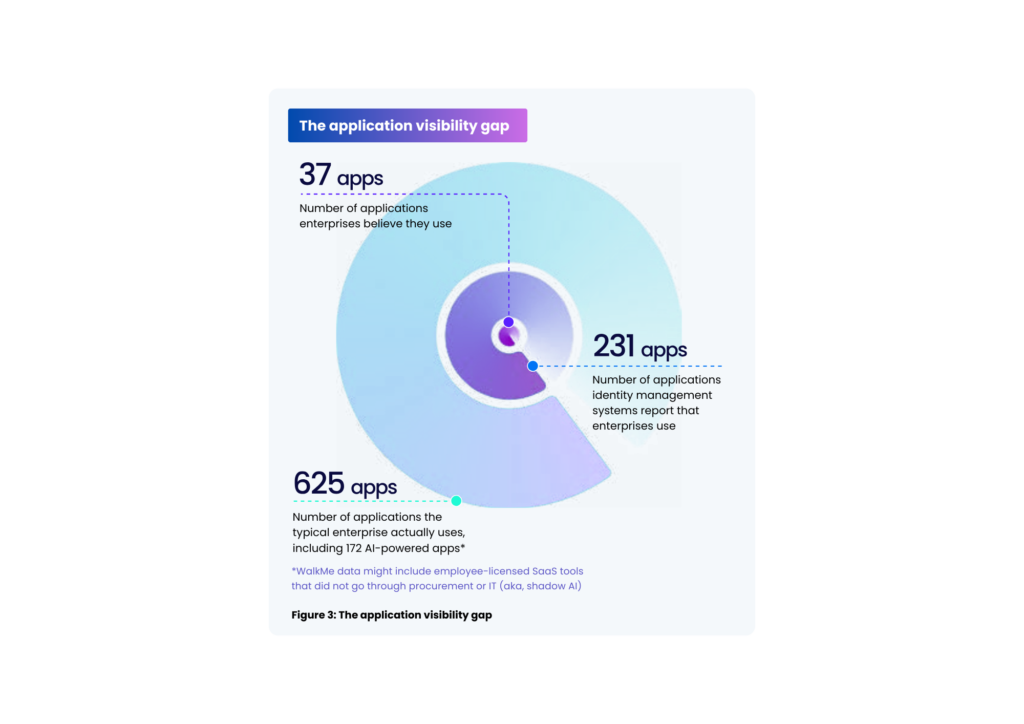
This massive visibility gap makes effective governance impossible. It leads directly to “Software Residue”—a term for redundant and overlapping applications. Our research shows that 20% of enterprise applications duplicate the features of other tools in the tech stack, representing millions in wasted licensing fees and contributing to a state of pervasive Software Paralysis. Without a clear understanding of what tools are in use, organizations cannot begin to optimize their processes or their investments.
1.3 The Human Cost: 36 Wasted Workdays and the "Toggle Tax"
The financial cost of this inefficiency is immense, but the human cost is equally devastating. The modern employee’s workflow is fragmented across an average of 10+ applications to complete a single task. This constant context-switching imposes a heavy “Toggle Tax” on productivity and morale.
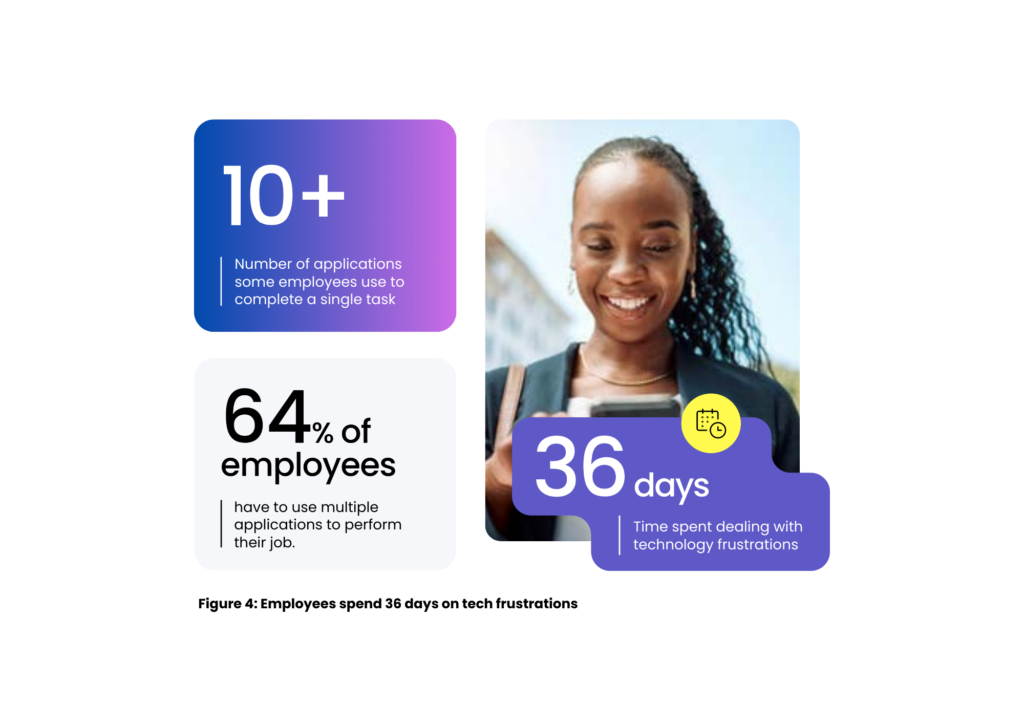
Our analysis, supported by the 2024 State of Digital Adoption Report, reveals the stark reality of the employee experience:
- The average employee loses the equivalent of 36 full working days per year dealing with technology frustrations and compensating for a lack of application proficiency.
32% of employees regularly have to work late because of hard-to-use technology. This frustration is a direct path to burnout and turnover, with over 65% of new employees losing patience with their enterprise software in just 132 days.
The friction is not trivial. 31% of employees have missed or made mistakes with holiday or sick leave requests in the past year due to poorly designed HR systems.
This is not a sustainable model. When the tools designed to empower employees become their biggest source of frustration, the entire foundation of digital transformation crumbles.
Chapter 2: The AI Accelerant - Navigating the Next Industrial Revolution
2.1 The Inevitable Integration: AI as 28% of the Enterprise Tech Stack
The digital paradox described in Chapter 1 is about to be supercharged. Generative AI is no longer an emerging technology; it is an integrated and rapidly expanding part of the enterprise ecosystem. Our analysis of over 2,400 enterprise applications reveals that AI-powered tools now account for 28% of the typical enterprise tech stack. This integration is happening at a pace that far outstrips previous technological shifts, forcing organizations to react.
However, the dominant reaction is one of dissonance. Leaders see the potential, but the workforce experiences the friction. This creates a dangerous gap between strategy and execution.
2.2 Deep Dive: The Great Disconnect
While executive suites are bullish on AI, a profound chasm exists between their strategic ambitions and the reality of employee readiness. This “Great Disconnect” is the single biggest threat to successful AI adoption and is clearly illustrated by the data:
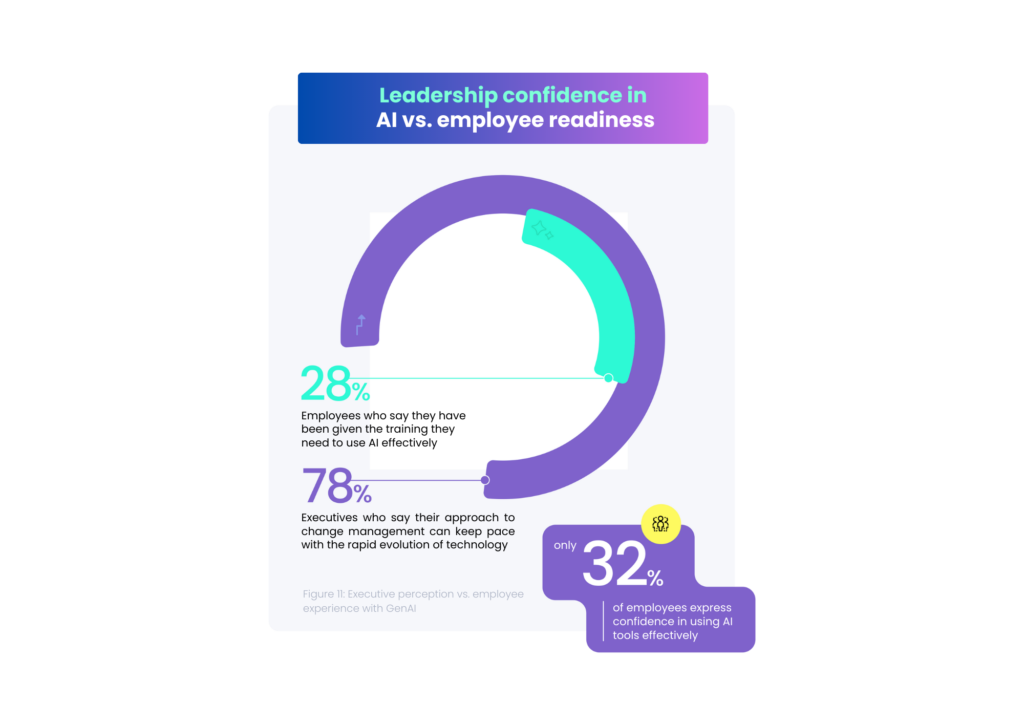
This disconnect is further illuminated by the divergent priorities of each group:
Leaders are focused on high-level outcomes. Their top priorities for GenAI are Performance Analytics (49%), Task Automation (40%), and Contextual Software Assistance (38%). They see AI as a tool for strategic gains.
Employees are focused on immediate, practical needs. Their top priorities are Application Guidance (52%), Risk Detection (47%), and Integration Between Existing Tools (44%). They see AI as another complex system they must learn to navigate safely and effectively.
Without a methodology to bridge this gap, organizations are simply investing in sophisticated technology that their workforce is unprepared and unequipped to use, ensuring a poor return on their substantial AI investments.
2.3 The Rise of Shadow AI and the Governance Imperative
The visibility gap is not limited to sanctioned software. The ease of access to consumer-grade AI tools has led to a surge in “Shadow AI”—the unsanctioned use of AI applications by employees to perform work tasks. While often born of a desire to be more productive, Shadow AI introduces significant risks, including data leakage, compliance violations, and the creation of insecure, unsupported workflows. The 172 AI-powered apps found in the average enterprise tech stack include many such unsanctioned tools, making a comprehensive governance strategy more critical than ever.
2.4 AI: A Multiplier for Transformation Debt or a Catalyst for HyperProductivity?
The evidence is clear: Generative AI is an accelerant. For organizations mired in transformation debt—with fragmented processes, poor visibility, and a disconnected workforce—AI will only compound the chaos. It will widen the productivity gap, increase security risks, and accelerate financial losses.
However, for organizations that approach its integration with a mature, human-centric methodology, AI can be a powerful catalyst, unlocking unprecedented levels of efficiency and innovation. This state of elevated performance is what we at erpOI call HyperProductivity. The deciding factor is not the technology itself, but the strategic approach to its adoption.
Chapter 3:The Methodological Divide -Why Traditional Implementations Fail
3.1 The "Go-Live" Fallacy: How the SI Model Engineers a 22% ROI
For decades, the standard for technology deployment has been the traditional System Integrator (SI) model. This model is fundamentally project-based, with the technical “go-live” as its primary—and often, final—metric of success. This approach is the architect of the digital paradox. By prioritizing the technology over the user, the SI model structurally ignores the human factors that are essential for value creation.
The result is a dismal 22% ROI on digital transformation projects for organizations that fail to implement a structured digital adoption strategy. The system is live, the SI’s project is “complete,” but the value has been left on the table.
3.2 Deep Dive: Defining the "Elite Digital Adopter"
In stark contrast to the laggards are the “Elite Digital Adopters.” This top 7% of enterprises have moved beyond the “go-live” fallacy and embraced a comprehensive, human-centric approach to technology integration. The results are transformative: they achieve a remarkable 85% ROI on their digital transformation projects.
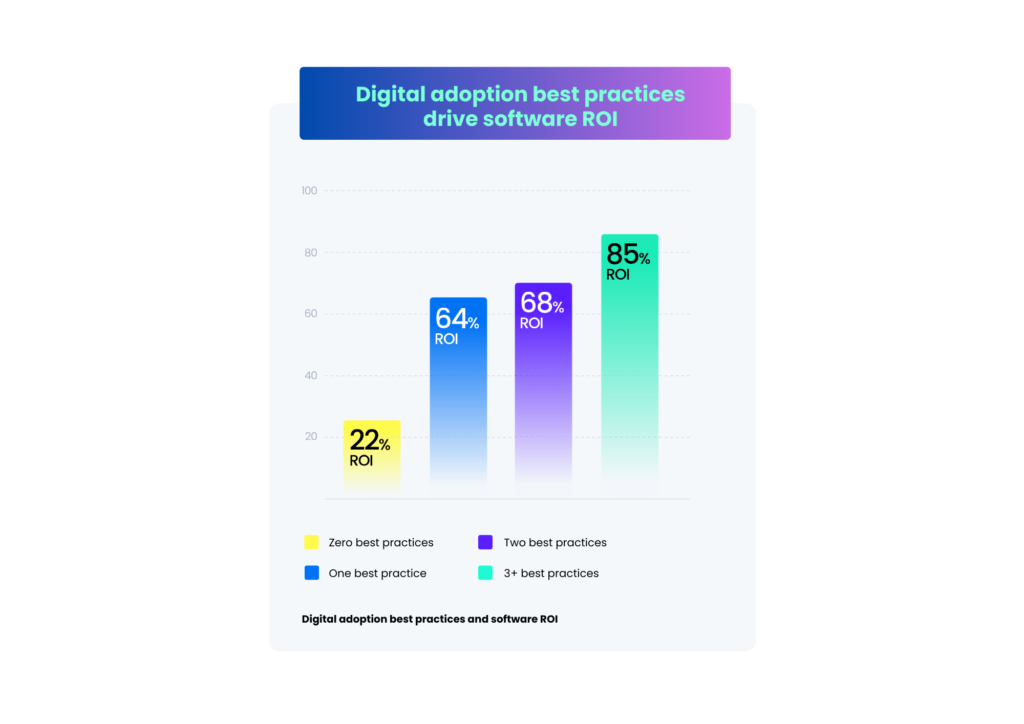
This ~4x difference in ROI proves that the methodology an organization uses to deploy technology is far more important than the technology itself. Elite Digital Adopters understand that adoption is not an event, but a continuous process driven by a set of core principles.
3.3 The 7 Digital Adoption Best Practices of Elite Organizations
Our analysis of the most successful organizations reveals a consistent pattern of behavior. Elite Digital Adopters build their strategy around seven core best practices:
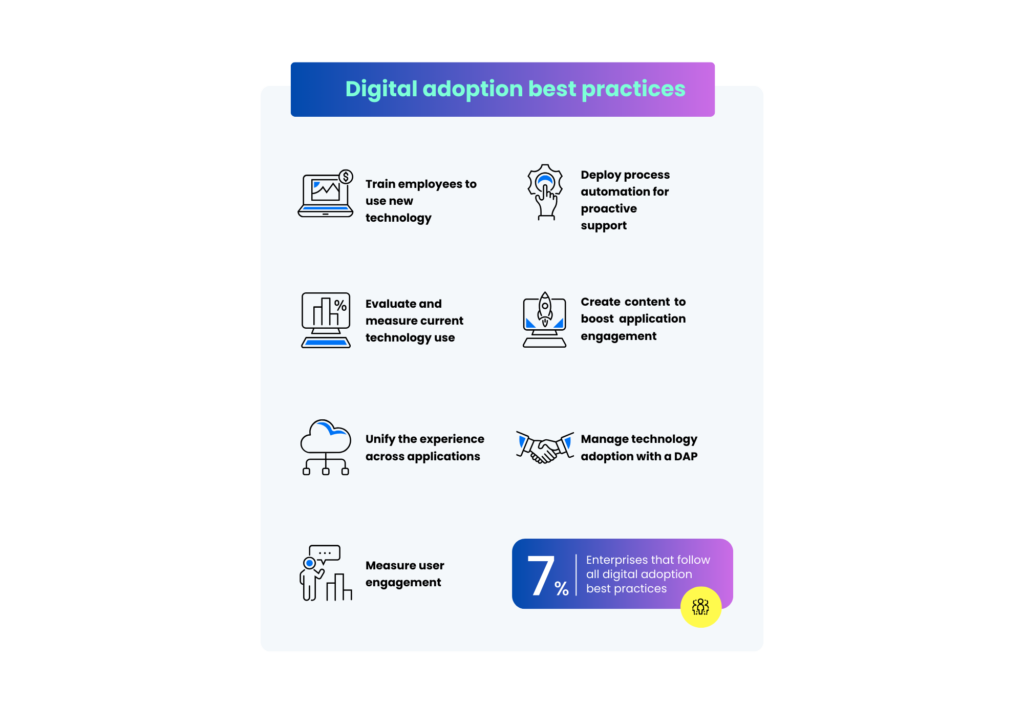
The 7 Best Practices Checklist
Moving beyond one-off sessions to continuous, in-flow enablement.
Gaining full visibility to make data-driven decisions.
Eliminating the “Toggle Tax” and creating seamless workflows.
Continuously monitoring for friction points and optimization opportunities.
Automating mundane tasks to free up human potential.
Providing the contextual help and resources users need, when they need it.
Utilizing a dedicated platform to orchestrate and scale the entire strategy.
3.4 The Role of the Center of Excellence (CoE) in Sustaining Elite Performance
Elite status is not achieved by accident, nor is it sustained without a dedicated focus. 73% of enterprises now have a Digital Adoption Center of Excellence (CoE) with six or more employees. This dedicated team is responsible for governing the digital adoption strategy, managing the DAP, and ensuring that best practices are consistently applied across the organization. The CoE is the organizational structure that operationalizes the principles of an Elite Digital Adopter.
The conclusion is inescapable: success in the modern digital landscape requires a fundamental shift away from the outdated SI model. It requires a new blueprint—one designed to create Elite Digital Adopters by systematically implementing a holistic, intelligent, and continuous approach to transformation.
Chapter 4: The erpOI Paradigm - A New Model for Continuous Evolution
The failures of the traditional, project-based model reveal the need for a new paradigm. At erpOI, we have developed a proprietary framework built for the realities of the modern digital enterprise. Our approach is not about managing a single project to completion; it is about embedding a capability for continuous evolution into the very fabric of an organization.
4.1 Visualizing the Journey: The Transformation Continuum
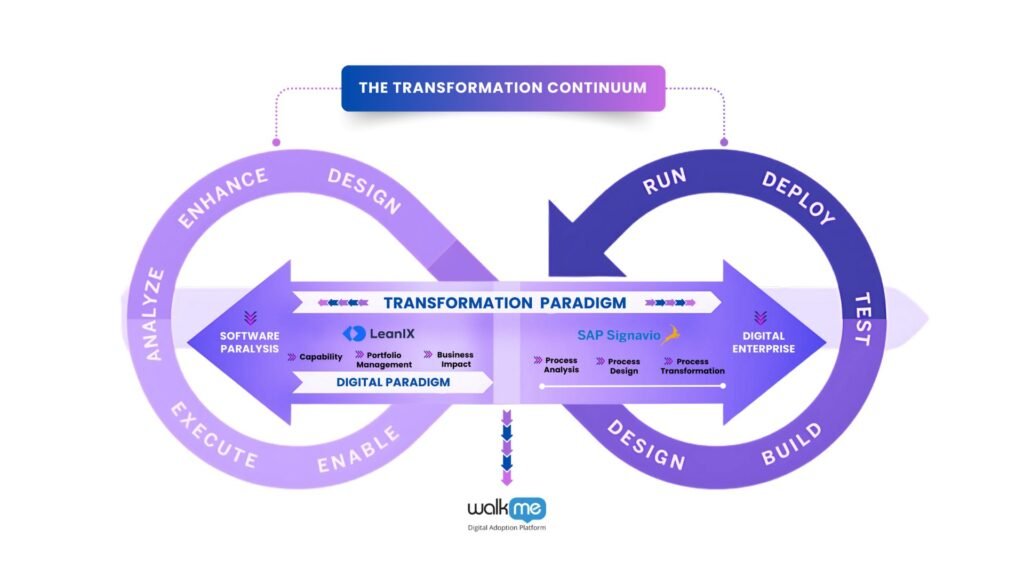
We reject the notion that transformation is a finite event with a beginning and an end. Instead, we see it as a perpetual journey: the Transformation Continuum. This model illustrates the spectrum of an organization’s digital maturity, from a state of “Software Paralysis”—where outdated systems and processes obstruct progress—to a dynamic state as a “Digital Enterprise,” characterized by agility and continuous innovation.
The goal is to move organizations permanently out of the gravitational pull of paralysis and into a sustainable orbit of continuous improvement. This requires a new operational engine.
4.2 Deep Dive: The Operations Integration & Intelligence (OI) Approach
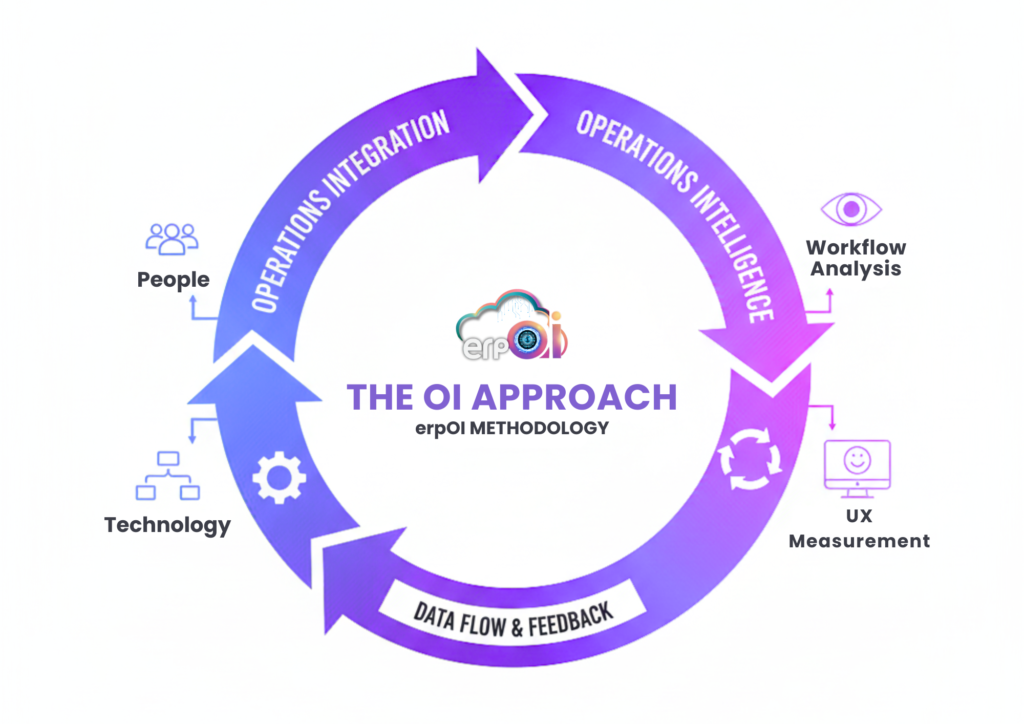
The engine driving the Transformation Continuum is our proprietary Operations Integration and Intelligence (OI) Approach. This is the core erpOI methodology for turning any organization into an Elite Digital Adopter. It is built on two synergistic pillars that form a continuous, self-improving loop.
Pillar 1: Operations Integration (The “How”) This pillar addresses the fundamental failure of traditional models by creating a single, cohesive, high-performance unit from the core elements of the business.
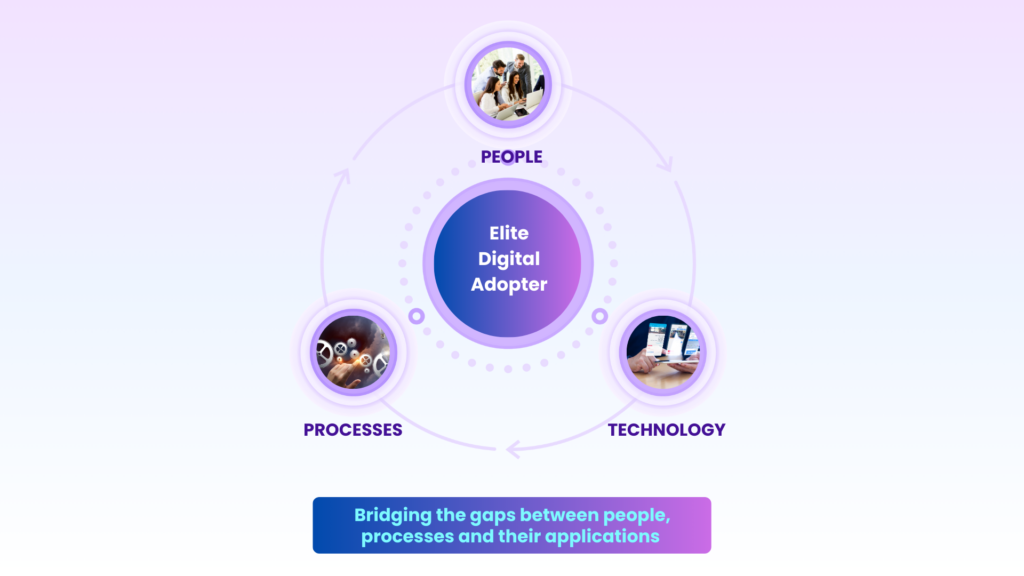
We shift the focus from episodic training events to continuous enablement. Our methodology ensures users are engaged, supported, and guided directly within their live workflows, fostering proficiency and confidence from day one. This directly addresses the “Great Disconnect” by building competence where it matters most.
We re-engineer processes with a human-centric focus. Instead of forcing users to adapt to rigid technology, we adapt the technological experience to the intuitive needs of the user. We use automation to eliminate friction, eradicate mundane tasks, and free employees for high-value strategic work.
We unify the tech stack not just at the data level, but at the user experience level. Our approach creates a seamless cross-application experience, treating the entire technology ecosystem as a single, coherent platform for getting work done.
Pillar 2: Operations Intelligence (The “Why”) This pillar replaces assumptions and guesswork with a data-first strategy, providing the clarity that 70% of enterprises currently lack.
Before we act, we assess. Leveraging Enterprise Architecture tools like SAP LeanIX, we map the entire IT landscape to expose redundancies, identify dependencies, and create a rational, data-driven foundation for the transformation roadmap.
We use advanced Business Process Mining tools like SAP Signavio to analyze end-to-end business processes as they truly exist. This allows us to move beyond theoretical process maps to identify the real-world bottlenecks, deviations, and inefficiencies that cripple productivity.
Finally, we deploy Digital Adoption Platforms to capture real-time, granular data on user interactions. We measure every click, hesitation, and error to identify the precise moments of friction that derail adoption and frustrate users.
The OI Approach creates a powerful feedback loop: Operations Intelligence provides the data-driven “why,” which informs the strategic actions taken within Operations Integration, leading to a continuously improving user experience and ever-increasing operational efficiency.
4.3 A Synergistic Tech Stack: How erpOI Leverages LeanIX and Signavio
Our OI approach is technology-agnostic in principle but strategically selects best-of-breed tools to deliver superior results. While WalkMe serves as our primary engine for user experience and adoption, our intelligence-gathering phase is significantly enhanced by our expertise in the broader SAP Business Transformation Suite.

SAP LeanIX for Strategic Alignment
LeanIX provides the “blueprint” of the enterprise. By visualizing the entire IT landscape, we can see how applications support business capabilities, identify aging technology that poses a risk (like an out-of-support SAP ECC system), and plan complex migrations like a move to S/4HANA with a clear understanding of all dependencies. This is the macro-level intelligence that ensures our adoption strategy aligns with the highest-level business objectives.

SAP Signavio for Process Excellence
While LeanIX provides the “what,” Signavio reveals the “how.” By mining and modeling existing workflows, we identify opportunities to standardize and optimize processes before embedding them in a DAP. This ensures we are not simply paving over broken paths, but are guiding users through a truly superior process, maximizing the ROI of the transformation.
This combination of strategic architecture management, deep process analysis, and real-time user adoption creates a multi-layered intelligence framework that is unique to erpOI, allowing us to design and implement solutions with unparalleled precision and impact.
Chapter 5: The erpOI Implementation Blueprint -From Strategy to Execution
